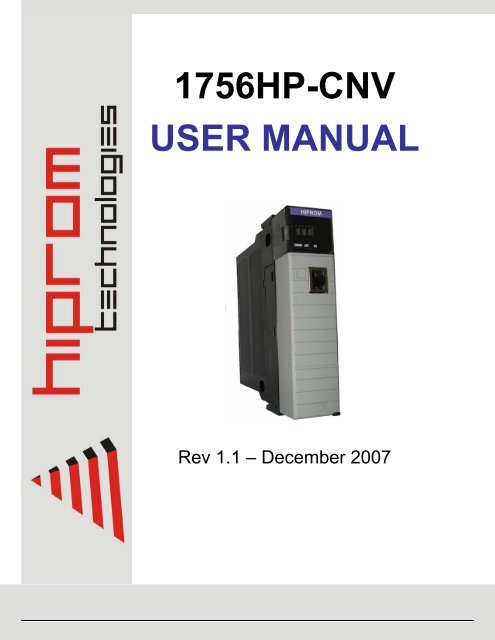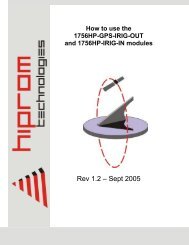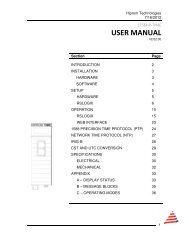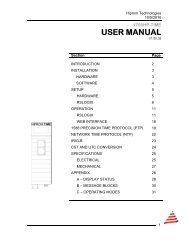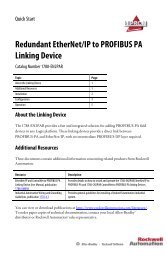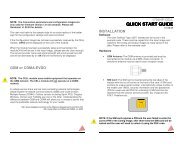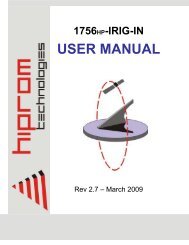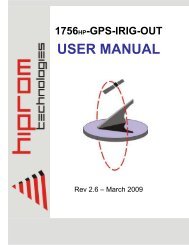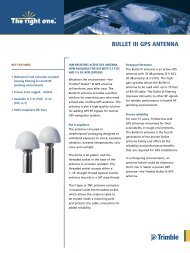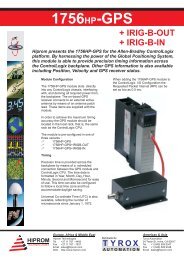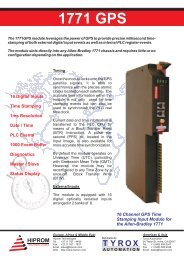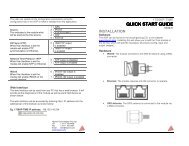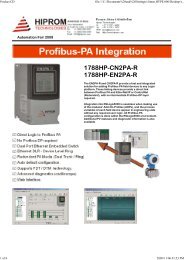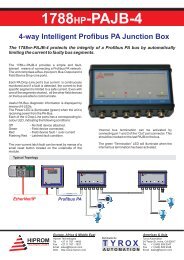1756HP-CNV USER MANUAL - Hiprom
1756HP-CNV USER MANUAL - Hiprom
1756HP-CNV USER MANUAL - Hiprom
- No tags were found...
You also want an ePaper? Increase the reach of your titles
YUMPU automatically turns print PDFs into web optimized ePapers that Google loves.
<strong>1756HP</strong>-<strong>CNV</strong><strong>USER</strong> <strong>MANUAL</strong>Rev 1.1 – December 2007
<strong>1756HP</strong>-<strong>CNV</strong> - User Manual Rev 1.1Table of ContentsChapter 1 Introduction.......................................................................................................3Chapter 2 Module Accessories.........................................................................................4Chapter 3 Module Operation.............................................................................................5Chapter 4 Installing the Module ........................................................................................6Chapter 5 Configuring the Module....................................................................................7Chapter 6 I/O Address Map ............................................................................................10Appendix A UDT Example.................................................................................................13Appendix B Specifications .................................................................................................17Page 2 of 17.
<strong>1756HP</strong>-<strong>CNV</strong> - User Manual Rev 1.1CHAPTER 1INTRODUCTIONThe <strong>1756HP</strong>-KeyID is the KeyID Master module for the Allen-Bradley ControlLogix PLCsystem that communicates with up to 30 KeyID slave modules. This enables the detectionof the KeyID status at each slave.This document serves to describe the functionality, installation, configuration and use ofthe module.Page 3 of 17.
<strong>1756HP</strong>-<strong>CNV</strong> - User Manual Rev 1.1CHAPTER 2MODULE ACCESSORIESThe module interfaces to the network via the RJ45 port located on the front of the module.The required cable is supplied with the module.Each <strong>1756HP</strong>-KeyID package includes the following components:• <strong>1756HP</strong>-KeyID module• 3m Cable• <strong>1756HP</strong>-KeyID user manualAlphanumeric DisplayStatus LED’sRJ45 PortPage 4 of 17.
<strong>1756HP</strong>-<strong>CNV</strong> - User Manual Rev 1.1CHAPTER 3MODULE OPERATIONThe <strong>1756HP</strong>-KeyID module is designed to operate within the Allen-Bradley ControlLogixPLC system. All power required for the module’s operation is derived from the 1756backplane.The <strong>1756HP</strong>-KeyID master module will communicate by broadcasting a packet to all of theslaves. The slaves will then reply in turn, according to address, with all the necessaryinformation. Should a slave not reply, a flag will be set indicating that it is offline. Shouldthe slave reply in future transmissions, it will be marked as online again.The current status of the module is conveyed to the user by means of the 3 bi-color StatusLED’s and the alphanumeric LED display.Page 5 of 17.
<strong>1756HP</strong>-<strong>CNV</strong> - User Manual Rev 1.1CHAPTER 4INSTALLING THE MODULEThe module is equipped with a RIUP (Removal and Insertion Under Power) circuitryenabling the module to be installed or removed from the chassis while power is applied.Attach the cable to the module via the RJ45 connector. Connect the communication wiresBlue (A), White/Blue (B), Brown (Ground) to the correct bus terminals of the 4-wirecommunications bus that runs to the slaves.Once the module powers up, it will immediately look at the parameters defined and startsearching for the KeyID slaves as set out in the parameters.Page 6 of 17.
<strong>1756HP</strong>-<strong>CNV</strong> - User Manual Rev 1.1CHAPTER 5CONFIGURING THE MODULE5.1. Establishing the Direct ConnectionThis section describes the procedures necessary to configure the <strong>1756HP</strong>-KeyID modulewithin the ControlLogix system. Each <strong>1756HP</strong>-KeyID module must be owned by a singleControlLogix controller.The 1756 Generic Module is used in RSLogix5000 to configure the module. Theconfiguration of the module is detailed in the table below.Data FormatCommFormatData – INTConnection parametersDescription Instance SizeInput 1 192Output 2 38Configuration 4 0RPIMin 5 msec Max 750.0 msecTable 5.1 : <strong>1756HP</strong>-KeyID connection parameters.The steps required to add a new <strong>1756HP</strong>-KeyID module are detailed below.Figure 5.1 : Right-click on I/O Configuration and select New ModulePage 7 of 17.
<strong>1756HP</strong>-<strong>CNV</strong> - User Manual Rev 1.1Figure 5.2 : Select Generic 1756 Module (1756-MODULE)Figure 5.3 : Configure module’s parametersPage 8 of 17.
<strong>1756HP</strong>-<strong>CNV</strong> - User Manual Rev 1.1Figure 5.4 : Configure module’s RPI (Requested Packet Interval)Once a modules configuration data has been downloaded to the controller, it will attemptto establish a connection with the module. A connection will fail if there is inappropriateconfiguration data.Page 9 of 17.
<strong>1756HP</strong>-<strong>CNV</strong> - User Manual Rev 1.1CHAPTER 6I/O ADDRESS MAPThe input and output image of the <strong>1756HP</strong>-KeyID module is defined in the followingsections. Appendix A provides an example UDT that can be used to extract and view thedata.6.1. Input ImageBitInt15 14 13 12 11 10 9 8 7 6 5 4 3 2 1 00 Reserved1 Reserved2 Online (Int 1)3 Online (Int 2)4 Reserved5 Reserved6 Slave 1 Status7 Slave 1 Voltage8 Slave 1 Temperature9 Slave 1 KeyID Status10 Slave 1 Analogue Input 111 Slave 1 Analogue Input 212 Slave 2 Status13 Slave 2 Voltage14 Slave 2 Temperature15 Slave 2 KeyID Status16 Slave 2 Analogue Input 117 Slave 2 Analogue Input 212 Slave 3 Status. .. .. .. .174 Slave 30 Status175 Slave 30 Voltage176 Slave 30 Temperature177 Slave 30 KeyID Status178 Slave 30 Analogue Input 1179 Slave 30 Analogue Input 2180 Reserved. .. .. .. .191 ReservedTable 6.1 : Input image.Page 10 of 17.
<strong>1756HP</strong>-<strong>CNV</strong> - User Manual Rev 1.1Int 0: ReservedInt 1: ReservedInt 2: Online – Bit 0 indicates if the slave with address 1 is online (1 – online, 0 – offline);Bit 1 indicates if the slave with address 2 is online; this continues to Bit 15,which holds the online status of the slave with address 16.Int 3: Online – Same as above, with Bit 0 providing the online status of the slave withaddress 17 and ends with Bit 13 for slave address 30.Int 4: ReservedInt 5: ReservedInt 6: Slave 1 Status bits.Int 7: Slave 1 Voltage – Indicates the supply voltage on the bus.Int 8: Slave 1 Temperature – Indicates the temperature of the slaves enclosure.Int 9: Slave 1 KeyID Status – Bit 0 to 7 indicates the KeyID input status in their respectiveorder. Bit 8 indicates the output 1 and Bit 9 the output 2 status.Int 10: Slave 1 Analogue Input 1 – Gives the analogue 1 input voltage (0-10V) as a 10bitnumber (10V = 1023).Int 11: Slave 1 Analogue Input 2 – Gives the analogue 2 input voltage (0-10V) as a 10bitnumber (10V = 1023).Int 12 – 179: Repetition of Int 6 to 11 for each slave as shown in table 6.1.Int 180 - 191: ReservedPage 11 of 17.
<strong>1756HP</strong>-<strong>CNV</strong> - User Manual Rev 1.16.2. Output ImageBitInt15 14 13 12 11 10 9 8 7 6 5 4 3 2 1 00 Reserved1 Reserved2 Reserved3 Maximum Slaves4 Control (Int 1)5 Control (Int 2)6 Slave 17 Slave 28 Slave 39 Slave 4. .. .. .. .35 Slave 3036 Reserved37 ReservedTable 6.2 : Output image.Int 0: ReservedInt 1: ReservedInt 2: ReservedInt 3: Maximum Slaves – Used to enter the address of the last slave on the line. Slaveswith an address higher than this address will not be scanned.Int 4: Control – Bit 0 indicates if the slave with address 1 must be polled again if removedfrom the scan list as indicated in Int 2 and 3 of the input image (1 – scanagain, 0 – ignore); Bit 1 indicates the scan status for slave 2 and thiscontinues to Bit 15, which holds the scan status for slave 16.Int 5: Control – Same as above, with Bit 0 providing the scan status of the slave withaddress 17 and this ends with Bit 13 for slave address 30.Int 6: Slave 1 - Used to send the output status that slave 1 should have. Bit 0 will changethe output status of Output 1 and Bit 1 will change the output status ofOutput 2.Int 7: Slave 2 - Used to send the output status that slave 2 should have. Bit 0 will changethe output status of Output 1 and Bit 1 will change the output status ofOutput 2.Int 8 - 35: Repetition of Int 6 and 7 for all the slaves (to address 30) as shown in table 6.2above.Int 36: ReservedInt 37: ReservedPage 12 of 17.
<strong>1756HP</strong>-<strong>CNV</strong> - User Manual Rev 1.1APPENDIX AUDT EXAMPLESee Figure A.1 below on how to create a new User Defined Type.Figure A.1 : Creating a new User Defined Data TypeCreate the first UDT called Slaves. This UDT consists of 32 bits with each Slave beingrepresented by a bit. This will be used to indicate the online status of the slaves. This isdetailed in Figure A.2 below. The last 2 bits will not have slave address and can be namednot used.Page 13 of 17.
<strong>1756HP</strong>-<strong>CNV</strong> - User Manual Rev 1.1Figure A.2 : UDT called Slaves. Used to indicate the online status of each slave.The next UDT is created to set out each individual slave’s values. The UDT is shown inFigure A.3.Figure A.3 : UDT called Slave_Values. Shows the values obtained from the slave.Page 14 of 17.
<strong>1756HP</strong>-<strong>CNV</strong> - User Manual Rev 1.1Next an UDT called KeyID_Inputs is created that uses all of the defined UDT’s. The copyinstruction will be used to copy the entire Input Image of the <strong>1756HP</strong>-KeyID module into aTag of type KeyID_Inputs. This will make accessing the values and information of eachslave much easier. Figures A.4 and A.5 detail the KeyID_Inputs UDT.Figure A.4 : UDT called KeyID_Inputs. Shows the first half of the UDT.Figure A.5 : UDT called KeyID_Inputs. Shows the last half of the UDT.Page 15 of 17.
<strong>1756HP</strong>-<strong>CNV</strong> - User Manual Rev 1.1Next an UDT called KeyID_Outputs is created. The copy instruction will be used to copythe entire Output Image of the <strong>1756HP</strong>-KeyID module into a Tag of type KeyID_Outputs.This will make accessing the values and information of each slave much easier. FiguresA.6 and A.7 detail the KeyID_Outputs UDT.Figure A.6 : UDT called KeyID_Outputs. Shows the first half of the UDT.Figure A.7 : UDT called KeyID_Outputs. Shows the last half of the UDT.Page 16 of 17.
<strong>1756HP</strong>-<strong>CNV</strong> - User Manual Rev 1.1APPENDIX BSPECIFICATIONSParameterSpecificationGeneralModule Location Any SlotElectricalBackplane Current 515mA @ 5.1V3mA @ 24VSchedules Connection ParametersRPI5ms to 750ms(………………./// end of document )Page 17 of 17.


